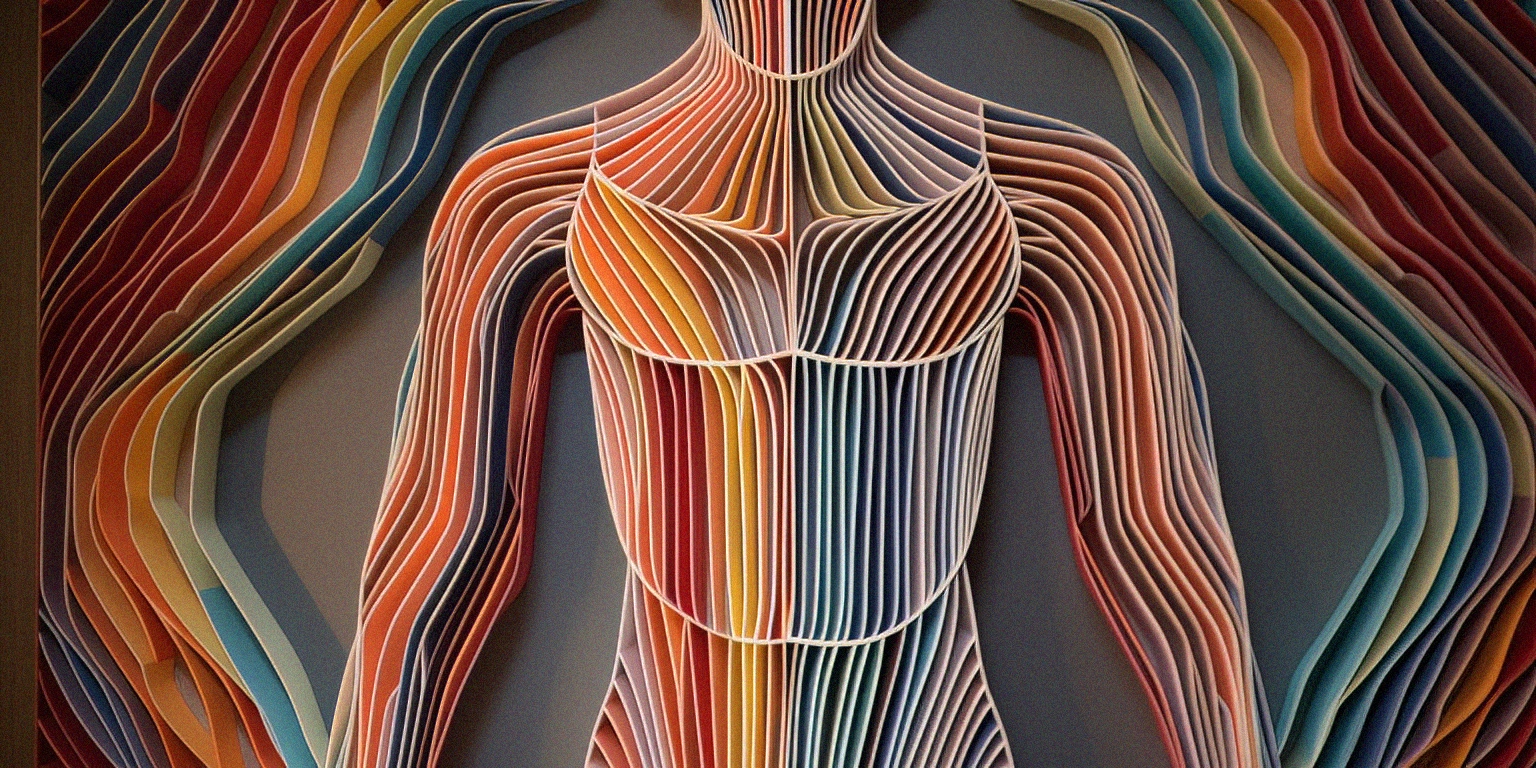You are fascia.
What is fascia, you may ask? Fascia is the continuous web of connective tissue that contains and protects everything in your body, from your muscles, organs, nerves, bones, and joints to your unprocessed emotions and past traumas. One uninterrupted sheet of fascia connects your toes to your eyebrows and your fingers to your chest and neck. When we are little bitty embryos in utero, as early as when we were just a bunch of clumped cells, the first organized tissue to develop is fascia, followed by all the other tissues, organs, and structures branching off of this original fascia. This is precisely how and why It surrounds, holds, supports, and shields every structure in our bodies. As a continuous web-like membrane that wraps, interweaves, and connects all bodily parts and processes, it supports the body as an integrated whole. There is no part of the body—not one single cell—that isn’t connected to this crystal-like lattice. Its elastic and liquid-like connective tissue delivers energy and information through its own independent nervous system, through the bio-electricity that it generates. It houses our human form in a continuous web of threadlike energy, which possesses ten times more sensory nerve receptors than the muscles in our body and has a signaling system very similar to that of our nervous systems.
Even though great strides have been made to bring awareness to the fascia, it is the least understood energy system and quite possibly the most important.
In terms of chronic pain that so many people suffer with, it’s critically important to know how fascia is implicated in this (especially before you go taking pain meds or getting unnecessary surgery!). The fascia forms the walls of the individual muscles, holding and binding our muscular network together. This web exists to help in our function and depending on our repetitive movements creates patterns and cycles of our postures and habits. Fascia is a graphic expression of how we feel and think—it reflects our past experiences, our attitudes, and our patterns of behavior. The fascia also dictates our basic body shape and how we hold and present ourselves to the world. As Julian Baker writes in Bowen Unraveled: A Journey into the Fascia Understanding of the Bowen Therapy: “In terms of fascia… collagen has a particular role, and supports our frequent movements and postures. If we were to hold a certain position for any length of time, we would experience stiffness. This stiff feeling is the beginning of collagen fibers lining up and thickening. Continued lack of movement or stiffness may eventually lead to ossification and atrophy, and is characteristic of so many stooped and painful postures we see around us.”
Pain is caused by a lack of proper circulation or a blockage in the flow of energy, impeding the flow of blood throughout the body. This can result in numbness, heaviness, stiffness, and swelling of the joints and muscles. Stress and long-term tension also slows down our circulation and becomes chronic inflammation in certain areas of the body. Stress and tension can literally tie our fascia in knots anywhere in the body. As tension in the fascia escalates, it forces our muscles to tightly grip us to a point where it’s nearly impossible to disentangle ourselves from it. If the fascia can’t return to it normal liquid state, we end up with a lot of toxins in our muscles and tissues. One surgeon was quoted as saying, “…on cutting into thickened fascia, a large of amount of pus gave way”..
It is important to note that restrictions in the fascia do not show up in any of the normal clinical tests, such as CT scans, X-rays, myelograms, or blood work. This is why, for a long time, myofascial problems were misdiagnosed, completely ignored, or worse—inappropriately treated.
Imagining the fascia as a liquid crystal flowing into every cell of the body, it’s no wonder that fascia has an extreme sensitivity and receptivity to our internal state and emotional landscape. Metaphysically, it is well-known that unexpressed emotions of the past can become locked in our tissues and organs. The fascia would then undoubtedly retain physical trauma, memories, scars, pain, and stress as well. All of these assaults can cause the fascia to tighten, and become knotted, congested, sticky, or brittle. So now there is not only restriction in the area of the injury, but it may also be affecting other areas of the body. This can cause layers of the fascia to become glued together restricting blood flow to joints, limiting nerve activity, and causing muscle contractions. Movement would be more painful, putting us in a holding pattern that affects the body, mind, and emotions. Because the fascia is a web, like a spider’s web, a pull in any one part, will cause a reverberation through the entire system.
As Mary Bond puts it in The New Rules of Posture: How to Sit, Stand, and Move in the Modern World, “Because the fascia connects to all body regions, adhesions in one place can create strain in distant areas. A stiff knee can derive from restricted fascial organization in a foot or hip, from adhesions around digestive organs, or even from an imbalanced head position due to hearing loss in one ear. Any immobilized region tugs on distant strands of the holistic fabric, distorting the entire organ of posture.” The New Rules of Posture: How to Sit, Stand, and Move in the Modern World by Mary Bond.
Dr. Gerald Pollack, celebrated scientist and author of The Fourth Phase of Water: Beyond, Solid, Liquid, and Vapor, documented that the water in our synovial fluid, joint fluid, and, most importantly, our cells, is “gel water” or “structured water.“
Your cells are like tiny ziplock bags full of jello-like water, which keeps our tissues in their proper shape and buoyancy.
Pollack’s work suggests that gel water is more hydrating than liquid water, because its unique electrical charge allows our systems to operate more efficiently, and its absorptive qualities help the body retain water. Gel water also has important implications for our understanding of the way water is distributed throughout the body. We have traditionally understood that water gets distributed via the bloodstream and lymphatic system, but the discovery of gel water suggests that fascia is also a critical system for water distribution. Fascia is made of collagen (which is full of gel water) and elastin, acting like a hydraulic system that pumps and distributes water more deeply into your tissues. When you move your fascia, or connective tissue, via exercise, it facilitates the movement of water throughout the body into every cell. Gel water also conducts electricity in the body far more efficiently than regular water because of its density and its unique, constantly changing structure. Another way to increase gel water in your body is to consume foods containing electrolytes like coconut, ghee, and chia seeds, for instance. The high electrolyte content releases an electrical charge when they begin to dissolve inside the body, creating a cascade of hydrogen bonding that triggers the creation of more gel water and, consequently, better hydration. Here are some tips for increasing hydration, healthier fascia, and thus a healthier YOU:
- Incorporate as many fruits and vegetables in your diet as you can. Not only are they full of gel water themselves, but they also contain naturally occurring electrolytes, and their fiber helps the body absorb gel water. For those reasons, a green juice or smoothie is actually more hydrating than a bottle of water.
- Add lemon or lime to water; the electrolytes help encourage the production of gel water.
- Drink and cook with bone broth, which is full of collagen (which is full of gel water).
- Add a teaspoon of crushed chia seeds to smoothies and other drinks. By crushing up the seeds, you create more surface area and, eventually, more gel water.
- Toss a pinch of unrefined sea salt (Celtic salt works well) into your water bottle. The electrolytes help encourage the production of gel water.
- Try cooking with coconut and ghee, which are both full of gel water and electrolytes.
- Use an Infrared sauna or a near infrared red light, or spend time in direct sunlight. The light waves in the red wave spectrum are able to reach the water molecules in our bodies and split them into positive and negative charges, shifting their molecular structure and creating gel water. The sun also does this and is nature’s built-in way of purifying and charging water, so spend time in direct sunlght each day, if possible. Sitting in front of a fire, such as a fireplace or a firepit, also emits the same red light spectrum, providing the same hydrating benefits.
- Get myofascial body work done, or use a myofascial tool on yourself to massage the fascia and bring circulation to it. One of my favorite myofascial practices is rolling achy body areas on a lacrosse ball or using an even a smaller myofascial ball, especially on the feet.
Fascia is the unsung hero of our physical and emotional well-being. It plays a vital role in keeping us healthy and happy. It’s time we give it the recognition it deserves.


